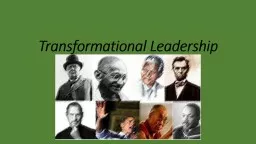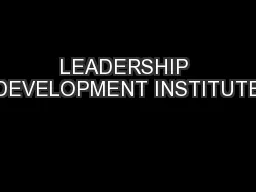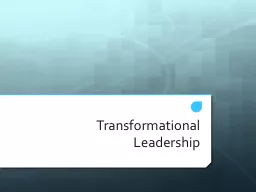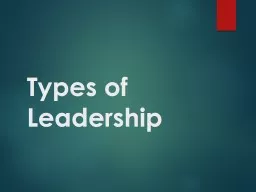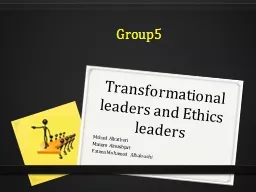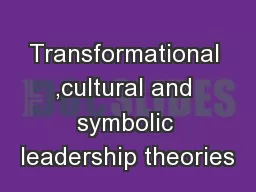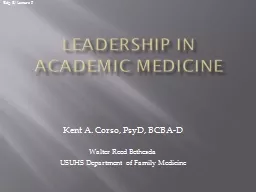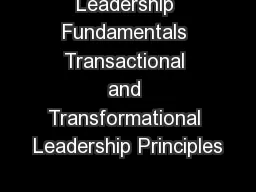PPT-Transformational Leadership
Author : yoshiko-marsland | Published Date : 2018-02-27
Feel the Burns Back in 1978 James MacGregor Burns published a leadership book describing several different types of leaders and leadership styles But the most important
Presentation Embed Code
Download Presentation
Download Presentation The PPT/PDF document "Transformational Leadership" is the property of its rightful owner. Permission is granted to download and print the materials on this website for personal, non-commercial use only, and to display it on your personal computer provided you do not modify the materials and that you retain all copyright notices contained in the materials. By downloading content from our website, you accept the terms of this agreement.
Transformational Leadership: Transcript
Feel the Burns Back in 1978 James MacGregor Burns published a leadership book describing several different types of leaders and leadership styles But the most important style that Burns identified within his leadership theory was the transformational leader. Leading for Change . Topic 7: Charismatic Leadership. Learning Objectives. Charismatic and transformational leadership. Understand:. how . the theories of charismatic and transformational leadership differ from earlier leadership theories.. TRANSFORMATIVE LEADERSHIP IN CHALLENGING TIMES. “Success under a good leader is people’s success.”. Lao Tzu, Chinese Taoist Philosopher. PETER F. DRUCKER. “. Managing in Turbulent Times”. Be . Description. New form of leadership identified in 1980.. One third of all leadership research is now on this form.. Transformational leadership fits the needs of today’s work groups who want to be inspired and empowered to succeed in times of uncertainty.. Most common Leadership Types. Autocratic . leadership. . . Bureaucratic leadership. . . Charismatic leadership. . Democratic leadership or participative leadership. . . Laissez-faire leadership. . . People-oriented leadership or relations-oriented leadership. . and Ethics leaders. Mshael. . A. lkatheri. . Mariam Almashjari. Fatima . M. ohamed . A. lbaloushi. Group5. Out line . Definition of transformational leadership. Example of . transformational . leadership. By . Abdulrahman. . Alnaim. 201100141. Transformational leadership . It’s a style of leadership in . which the followers and the group members follow the leader who . has a future vision and plan and lead them by inspiration.. Mel Gill. Student Support & Guidance Tutor. School of Education. Writing academically. Some students make the mistake of thinking that level 6 writing means using complex English and the longest words possible in order to show just how clever they are. . Organizational Settings. McGraw-Hill/Irwin. Copyright © 2013 by The McGraw-Hill Companies, Inc. All rights reserved.. The Leadership of Steve Jobs. During his life, Steve Jobs won numerous awards for his transformational and charismatic leadership. The co-founder of Apple, Inc. and Pixar animation Studios was equally renowned as a demanding perfectionist with less-than-ideal people skills.. Something Funny.... Leadership Skills Test. http://www.mindtools.com/pages/article/newLDR_50.htm. Personal Characteristics. I doubt myself and my ability to succeed.. Not at All. 5. Rarely. 4. Sometimes. Robert McKennett, CRNA, MA, MSN, NEA-BC. Objectives. Compare and . contrast theories . of . leadership. Describe transformational theory’s impact on . the Magnet© journey. List the four key elements of Transformational Leadership. Kent A. Corso, . PsyD. , BCBA-D. Walter Reed Bethesda. USUHS Department of Family Medicine. Bldg. E/ Lecture F. OBJECTIVES. To describe the leadership theories that are most applicable to leadership in academic medicine.. The Mistakes We Make. “Leadership can be developed. However, it cannot be ‘promoted.’”. -Dan Chase (June 16. th,. 2015). “There go the people. I must follow them, for I am their leader." . Lay Servants as Christian Transformational Leaders. WELCOME!. To help participants engage in personal and corporate reflection and assessment.. To provide a scriptural foundation for Christian transformational leadership.. The Mistakes We Make. “Leadership can be developed. However, it cannot be ‘promoted.’”. -Dan Chase (June 16. th,. 2015). “There go the people. I must follow them, for I am their leader." .
Download Document
Here is the link to download the presentation.
"Transformational Leadership"The content belongs to its owner. You may download and print it for personal use, without modification, and keep all copyright notices. By downloading, you agree to these terms.
Related Documents

